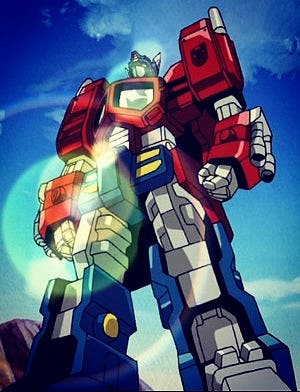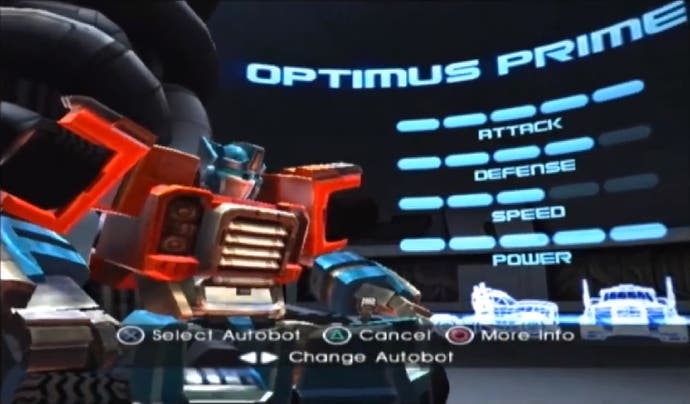How a slightly wonky Transformers show gave us a proper video game classic
Twenty years later, Melbourne House's game holds up.
Hello! Just to say: yes, Graeme wrote a lovely retrospective of this game almost a decade ago and it's a terrific read. But with the game on people's minds again it felt like a welcome opportunity to revisit a real PS2 legend.
Did you know that Transformers will be 40 years old next year? Yep, the long running franchise that started life as a (blindingly successful) attempt to sell Japanese robot toys to American kids is almost as old as me. Being a fan of something for that long, especially when it's never really taken a break, can be a bit weird, as one day you'll suddenly realise that the bits that you remember being new-fangled upstarts are now old enough to vote and have kids and stuff. Y'know, if they were people and not cartoons and toys and whatnot.
Transformers Armada is one of those things. Released in 2002, the cartoon and accompanying toyline kicked off what has become known as the Unicron Trilogy, and is a bit of a mixed bag. The show was absolute bobbins, even before taking into account a lot of jank caused by production problems. Although there were some great toys, many were hampered by assorted gimmicks, resulting in limited articulation and transformation in order to allow for wee-woo noises, flashing lights and spring-loaded flaps.
There is one part of the Transformers Armada media blitz that was bloody great and still holds up today. Surprisingly (unless you remembered you're reading this on a video game website) it's the 2004 PlayStation 2 tie-in, simply titled Transformers. Developed by Melbourne House (possibly the first game developer my tiny brain was ever aware of, thanks to Way of the Exploding Fist) and published by Atari, Transformers is a (mostly) third-person shooter set across a series of sprawling, open levels. From your base/hub/glorified level select screen, you'll pick one of three Autobots, who will almost certainly be Optimus Prime, and which of the unlocked levels you want to travel to. Once you've arrived via advanced Cybertronian teleportation trickery, your job is to navigate the level, fighting hordes of generic Decepticon grunts until you have a showdown with the named boss baddie at the end.

It's classic video game action superbly executed. Optimus and chums have a solid heft to their movement, a satisfying inertia that conveys their size and weight, despite the scarcity of human-scale environments (and total lack of humans) for comparison. While you can just run in, guns blazing, enemies can soak up a lot of punishment and dish out a fair amount of their own. Instead, you may want to try a stealthy, sniper approach, switching into first person mode (which you can still freely move around in, it's not just a zoom function) and trying for a few headshots before engaging fully.
Of course you're not limited to combat on two legs either. Switch into vehicle mode (or alt mode, to use the correct lingo) and you can charge into a cluster of goons, bowling them over and leaving them open to some well placed plasma rounds. Hit-and-run tactics can be very effective and there's frequently nothing stopping you from just driving around them. The large levels and predictable enemy patrols lend themselves to this kind of forward planning. You can also just punch them, but it's not great and if you desperately want to do that, you should play Transformers: Devastation instead.
It's a good foundation for a game, especially when you consider how many others just can't get the fundamentals right. But to see what makes Transformers really special, we have to go back to the source material and throw in a bonus history lesson. The Transformers brand has always been a convoluted mix of Japanese and American parts. The original toys were Japanese, licensed and rebranded by Hasbro and marketed with American-made cartoons and comics. After a couple of years licensing every random Japanese transforming robot toy it could (which is why the original toy line features cars and trucks alongside cameras, cassette recorders and space dragon-dinosaur-chicken-cat things) Hasbro started releasing its own original toys. Meanwhile, Japanese company Takara imported the whole shebang back to Japan, where it proved to be vastly more popular than the original toys it was based on. When the American line and cartoon started to wind down, Takara made new toys and shows, resulting in a slew of weird and wonderful toys that are collector gold dust today.

Transformers Armada was the first true collaboration between Hasbro and Takara. The cartoon was made in Japan and turn of the century kids' anime with international appeal could only mean one thing; it had to be Pokémon.
It's hard to overstate how huge Pokémon was and how the resulting anime boom dictated the children's TV landscape for years. While Transformers had always had human characters befriending the Autobots, Armada saw a group of teens thrust front and centre, consisting of the classic trio of Heroic Protagonist Boy, Smart Girl and Other Guy. More importantly, it introduced the diminutive Minicons. Tiny Transformers weren't new to the franchise, but this time the whole thing revolved around them. Minicons were depicted as a third faction of robots who could be attached to their bigger brethren in order to increase their power. The cartoon was a scramble to grab as many of the little blighters as possible before the Decepticons did. The toys came with Minicon partners that could be plugged into various ports to activate the aforementioned gimmicks.
In the game, Minicons were classic power ups. Scattered across each level were a number of collectables, some of which contained unlockable art and such. Most of them, however, were much more exciting, containing a new Minicon to add to your arsenal. Up to four can be equipped at once, mapping to the four shoulder buttons, and bestow a range of offensive, defensive and support powers. These range from replacements for your basic blaster, to rockets, grenades and shields. Some can dramatically boost certain playstyles when used in concert. Combine Lookout, the sniper rifle, with the increased range of Rangefinder and you can happily headshot your way through whole groups of enemies before they can get close enough to get a shot off! Minicons are also sorted into colour-coded teams and equipping two or more of the same colour boosts your power, adding an additional layer of loadout planning, while also hinting at which ones may work well together.
Perhaps the most interesting Minicons are the ones that enhance your movement capabilities, particularly Slipstream, who acts as a glider pack. Each level clearly displays how many collectables are available and completionists will find that there are some that they can't even find, let alone reach, on their first visit. Transformers allows you to revisit levels from the hub at any time which opens up an almost metroidvania-like loop of returning to completed areas with new powers in order to hunt down the last few Minicons, which can in turn enable further exploration. Gotta catch 'em all!
The absolute bestest-best bit of Tranformers, the bit that has lodged itself in many people's brains, even if they can't remember a damn thing about the rest of the game, is also a massive spoiler. If I've convinced you to rush out and track down a copy of the game (not hard, it's cheap as chips second-hand and PS2s aren't exactly in short supply if you don't want to faff with emulation) then I suggest you do so now. Seeya!
About half way through the game, you'll find yourself somewhere in the Atlantic ocean, on a small island. You pick your way across rocky outcroppings, before boarding a huge Decepticon ship and fighting your way through it, deck by deck. It's intense, close quarters combat and a lot of fun. Reach the end and you're treated to an impressive CGI cutscene as the entire level you just played transforms and stands up, revealing the ship to be the massive Decepticon Tidal Wave. Who you now have to fight, despite him being considerably larger than you. It is, once again, classic video game stuff married perfectly to the source material.
This is the heart of what makes Transformers such a gem. There's no single element that is earth-shatteringly amazing or original and it looks about as good as you'd expect a twenty-year-old PS2 game to look. Instead, it's clearly thoughtfully crafted, taking a rock-solid action game foundation and building on it using elements from the source material that add to and compliment the core, instead of feeling jammed in to complete a box-ticking exercise. Released at a time when everything had a hastily thrown-together video game tie-in, it was easy to miss. While much of it seems a little crude now, it's still an absolute blast and the perfect way to celebrate/commiserate Rise of the Beasts being brilliant/rubbish!

